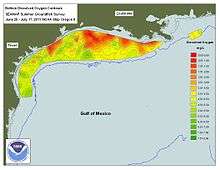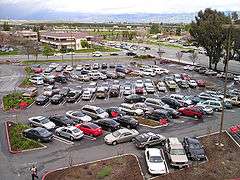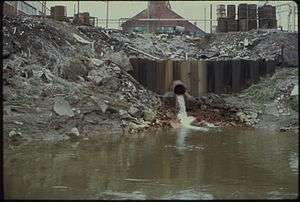Water pollution in the United States
(NRCS_Photo_Gallery).jpg)
Since the 1960s, water quality in surface water bodies in the United States has generally improved, due to the implementation of the 1972 Clean Water Act. However, many water bodies are still being polluted from one or more categories of sources, which may include agriculture, industry, or urban runoff.
Overview

Since the passage of the 1972 Clean Water Act (CWA), the levels of water pollution in the United States generally have experienced a dramatic decrease. The law has resulted in much cleaner waterways than before the law was implemented.[1]
However, more than half of U.S. stream and river miles continue to violate water quality standards. Surveys of lakes, ponds and reservoirs indicated that about 70 percent were impaired (measured on a surface area basis), and a little more than 70 percent of the nation’s coastlines, and 90 percent of the surveyed ocean and near coastal areas were also impaired.[2]
Agriculture, industry, communities (typically through urban runoff) and other sources continue to discharge waste into surface waters nationwide, and many of these waters are drinking water sources. In many watersheds nutrient pollution (excess nitrogen and phosphorus) has become a major problem.[3]
It is argued in a 2008 paper that the CWA has made extremely positive contributions to the environment, but that the law does not address some aspects of pollution well, or at all, and that Congress should revise or expand the law to address these problems.[4]
Municipal sewage
Sewage pollution became a widespread problem with the onset of the industrial revolution in the 19th century, population growth and increasing urbanization. Through the early 20th century, most communities had no sewage treatment plants. Many cities built sewer pipes which carried the sewage to a nearby river or coastal area, but without any treatment of the wastes. The first plants that were built in the late 19th and early 20th centuries typically did not fully treat the wastes.[5]
In the 1972 CWA, Congress created a major public works financing program for building and upgrading sewage treatment plants. This grant program was transitioned to a low-interest loan program in the 1987 amendments to the act.[6] Ideally, the municipal wastewater treatment process comprises three stages:
- Primary treatment: Physical processes that remove conventional pollutants: 60 percent of suspended solids and 30 percent oxygen-demanding waste; as well as 20 percent of nitrogen compounds;
- Secondary treatment: the process that aerates the treated waste, allowing a biological process that eliminates 90 percent of oxygen-demanding waste, 30 percent suspended solids, nitrogen compounds, and most toxic metal compounds;
- Tertiary treatment: further treatment to remove additional amounts one or more classes of pollutants, such as conventional pollutants, nutrients and bacteria.[7]
A tertiary treatment facility is typically four times more expensive to operate, compared to a secondary treatment system, so it is used only when absolutely necessary. Today over 75% of the population is served by more than 16,000 municipal sewage plants, and most treatment plants in the U.S. include secondary treatment components. Federal regulations require secondary treament plants to remove 85% or more of the biochemical oxygen demand (BOD) and suspended solids.[8]:4 [9]
The methods of municipal sewage treatment in the United States produce a large amount of bacteria since the soluble organic matter is converted to biomass, which is also known as biosolids and these are applied to soils as fertilizers or source of water in the case of water effluents to improve soil productivity or enhance revegetation.[10] The land application of treated biosolids and effluent, which started to increase after the restriction to ocean dumping, helps reduce pollution particularly in areas where the surface water is not capable of assimilating elements such as nitrogen and phosphorus. The excessive amount of these chemical elements lead to pollution.[10]
With the widespread implementation of secondary treatment technology, water quality has greatly improved in many watersheds nationwide.[1] However, many municipal plants are being challenged to confront some significant remaining problems:
- Many cities have combined sewers, which can cause discharges of untreated sewage during large storms.[8]:7
- Many plants discharge nutrients (nitrogen and phosphorus), which are only partially controlled by secondary treatment processes.[8]:8 Some of these plants have additional systems to treat nutrients (tertiary treatment), but additional control for nutrients is a continuing concern in communities nationwide.[11]
Urban runoff

A growing body of water research during the late 1970s and 1980s indicated that stormwater runoff was a significant cause of water quality impairment in many parts of the US.[12] Increased land development throughout the country—in both cities and suburbs—has led to an increase in impervious surfaces (parking lots, roads, buildings, compacted soil), which generates increased surface runoff during wet weather. Congress responded to the stormwater problem with the enactment of the Water Quality Act of 1987. The law defines industrial stormwater dischargers and municipal separate storm sewer systems (often called "MS4") as point sources, and requires these facilities to obtain discharge permits under the National Pollutant Discharge Elimination System (NPDES).[13]

To implement the 1987 law, thousands of local governments established stormwater management programs. Each regulated municipality developed standard program elements as required by EPA regulations:
- Local regulation of construction site runoff controls (i.e., erosion and sediment controls)
- Illicit discharge detection and elimination
- Pollution prevention and "Good Housekeeping" measures (e.g. maintenance of storm drain system and use of best management practices)
- Local requirements for post-construction (i.e., permanent) runoff controls (e.g., infiltration basins, constructed wetlands)
- Public education and outreach program
- Procedures for public involvement and participation.[14][15]
About 855 large municipal stormwater systems (serving populations of 100,000 or more), and 6,695 small systems are regulated by the permit system.[16]
While the industrial and MS4 facilities are now regulated through NPDES permits, stormwater management in communities is an ongoing challenge. A 2008 report by the United States National Research Council identified urban runoff as a leading source of water quality problems: "Stormwater runoff from the built environment remains one of the great challenges of modern water pollution control, as this source of contamination is a principal contributor to water quality impairment of waterbodies nationwide. In addition to entrainment of chemical and microbial contaminants as stormwater runs over roads, rooftops, and compacted land, stormwater discharge poses a physical hazard to aquatic habitats and stream function, owing to the increase in water velocity and volume that inevitably result on a watershed scale as many individually managed sources are combined."[17]
As of 2018, EPA and state water quality agencies have estimated that urban runoff is a probable source of impairment for at least 48,000 miles (77,000 km) of rivers and streams; 799,000 acres (3,230 km2) of lakes, reservoirs and ponds; and 317 miles (510 km) of coastal shoreline.[18]
Pollution incidents
- Buffalo Creek flood
- Camp Lejeune water contamination
- Cruise ship pollution in the United States
- Hinkley groundwater contamination
- Kingston Fossil Plant coal fly ash slurry spill
- Lead contamination in Washington, D.C. drinking water
- Martin County coal slurry spill
- Water contamination in Crestwood, Illinois
- 2015 Gold King Mine waste water spill
- Woburn, Massachusetts#Groundwater contamination incident
Polluted water bodies (partial list)

- Ohio River, ranked as the most polluted river in the United States in 2010[19]
- Onondaga Lake
- Aliso Creek (Orange County)
- Bubbly Creek
- Cuyahoga River
- Duwamish River
- Elizabeth River (Virginia)
- Houston Ship Channel
- Housatonic River
- Hudson River
- Kamilo Beach
- Love Canal
- Newark Bay
- Newtown Creek
- New River (Mexico – United States)
- Passaic River
- Lake Erie
- Lake Gribben
- Savannah River[20]
See also
- Summary information
- Clean Water Act programs
- American Heritage Rivers
- Clean Water State Revolving Fund (financial assistance program)
- Effluent guidelines (wastewater regulations)
- Nationwide Urban Runoff Program (research)
- New Source Performance Standard (wastewater regulations)
- Total maximum daily load (wastewater regulations)
- WaterSense (EPA conservation program)
- Specific topics
- Effects of hydraulic fracturing on water quality in the United States
- Pollution of the Chesapeake Bay
- Great Lakes#Pollution
- Anderson v. Cryovac
- Groundwater contamination from animal agriculture
- General
References
- 1 2 Water Pollution Control: 25 years of Progress and Challenges for the New Millennium (Report). Washington, D.C.: United States Environmental Protection Agency (EPA). June 1998. EPA 833-F-98-003.
- ↑ "National Summary of State Information". Water Quality Assessment and TMDL Information. EPA. Retrieved 2018-05-21.
- ↑ "Nutrient Pollution: The Problem". EPA. 2017-03-10.
- ↑ Andreen, William L.; Jones, Shana C. (July 2008). The Clean Water Act: A Blueprint For Reform (PDF) (Report). Edgewater, MD: Center for Progressive Reform. CPR White Paper #802.
- ↑ Metcalf & Eddy, Inc. (1972). Wastewater Engineering. New York: McGraw–Hill. pp. 4–6.
- ↑ Copeland, Claudia (2012-04-05). Water Infrastructure Financing: History of EPA Appropriations (PDF) (Report). U.S. Congressional Research Service.
- ↑ Smith, Zachary (2017). The Environmental Policy Paradox. Routledge. ISBN 9781317226628.
- 1 2 3 Primer for Municipal Wastewater Treatment Systems (Report). Washington, D.C.: EPA. 2004. EPA 832-R-04-001.
- ↑ EPA. "Secondary Treatment Regulation." Code of Federal Regulations, 40 C.F.R. 133.102
- 1 2 Gerba, Charles; Brusseau, Mark (2006). Environmental and Pollution Science. Burlington, MA: Academic Press. p. 452. ISBN 9780125515030.
- ↑ "Sources and Solutions: Wastewater". Nutrient Pollution. EPA. 2018-01-30.
- ↑ For example, see the Nationwide Urban Runoff Program (1979-83).
- ↑ United States. Water Quality Act of 1987, Pub.L. 100–4. February 4, 1987. Added Clean Water Act section 402(p), 33 U.S.C. § 1342(p).
- ↑ "Stormwater Discharges from Municipal Sources". NPDES. EPA. 2018-04-04.
- ↑ EPA. NPDES Program Regulations. §122.26: Storm water discharges. §122.34: Permit requirements for regulated small MS4 permits. Code of Federal Regulations, 40 C.F.R. 122.26 and 40 C.F.R. 122.34.
- ↑ "Overview". NPDES / Stormwater Discharges from Municipal Sources. EPA. 2018-04-04.
- ↑ National Research Council (United States) (2009). Urban Stormwater Management in the United States (Report). Washington, D.C.: National Academies Press. p. vii. doi:10.17226/12465. ISBN 978-0-309-12539-0.
- ↑ "National Probable Sources Contributing to Impairments". National Summary of State Information. EPA. Retrieved 2018-07-15.
- ↑ "Report: Ohio River most polluted in U.S." Pittsburgh Business Times. March 23, 2012. Retrieved April 24, 2012.
- ↑ Coleman, Dash. "Report calls Savannah River third most toxic in America".
External links
- Water Topics at the Environmental Protection Agency
- Find out what's in what you're drinking: Search the US Tapwater Database | Environmental Working Group
- Report: Virginia second in nation in water pollution (WTVR.com, March 23, 2012)
- "Wasting Our Waterways: Toxic Industrial Pollution and Restoring the Promise of the Clean Water Act" (2014) - Environment America Research & Policy Center